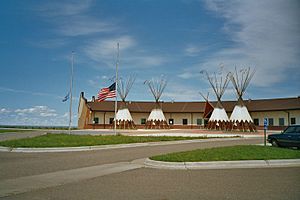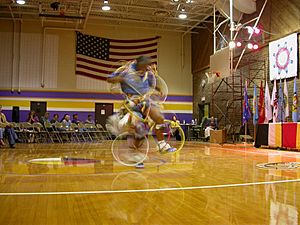Lower Brule Indian Reservation facts for kids
Quick facts for kids
Lower Brule Indian Reservation
Khulwíčhaša Oyáte (Lakota)
|
|
|---|---|

Administration Center, Lower Brule Indian Reservation
|
|

Location of Lower Brule Indian Reservation, South Dakota
|
|
| Country | United States |
| State | South Dakota |
| Counties | Lyman / Stanley |
| Government | |
| • Type | Tribal Council |
| Area | |
| • Total | 207.189 sq mi (536.617 km2) |
| Population
(2004)
|
|
| • Total | 1,308 |
| Time zone | UTC-7 (MST) |
| • Summer (DST) | UTC-6 (MDT) |
| Website | Lower Brule Sioux Tribe Official Website: http://www.lbst.org/ |
The Lower Brule Indian Reservation is the home of the Lower Brule Sioux Tribe. Its name in the Lakota language is Khulwíčhaša Oyáte, which means 'lower men nation'. This reservation is located in central South Dakota, on the west bank of the Missouri River. It sits across the river from the Crow Creek Indian Reservation. The Lower Brule Sioux are part of the Sicangu band, who are a group within the larger Lakota people. The main offices for the tribe are in a town called Lower Brule.
Contents
- Understanding the Sioux People
- Working and Jobs on the Reservation
- How the Tribal Courts Work
- Important Buildings and Services
- Homes on the Reservation
- Community Services
- Fun and Recreation
- Getting Around
- Learning and Education
- Important People from the Tribe
- Stories and Media
- Images for kids
- See also
Understanding the Sioux People
The Sioux are a large group of Native American tribes. They govern themselves and speak one of three related languages. These languages are Eastern Dakota, Western Dakota, and Lakota.
- The Eastern Dakota, also known as Santee, lived in areas from the Ohio River valley to South Dakota.
- The Western Dakota, called Yankton or Yanktonai, lived from eastern Minnesota to the Missouri River valley.
- The Lakota, also known as Western Teton Sioux, lived east of the Missouri River valley all the way to the Rocky Mountains.
These groups share a common history and language. They deeply respect the land and nature. They also share traditions like using pipestone and holding ceremonies. Some of these ceremonies include the Sun Dance, sweat lodges, and vision quests.
Why the Name "Brule"?
The name "Brule" comes from a French word, brûlé, which means "burnt." French fur traders gave this name to the Sicangu people in the late 1600s. In the late 1700s, the Sicangu split into two groups: the Lower Brule and the Upper Brule. The Lower Brule preferred to live near where the White River meets the Missouri River. The Upper Brule lived further south and west.
Protecting Sacred Places
The Lower Brule Sioux Tribe works hard to protect their sacred places and improve the environment. For example, in 2013, they asked a TV station, KELO-TV, to move a fallen transmission tower. This tower was on Medicine Butte, a hill that is very important to the Sicangu people. Medicine Butte rises about 200 feet above the land. KELO-TV agreed and moved the tower to a different spot.
Working and Jobs on the Reservation
The main employers on the Lower Brule Indian Reservation are the tribe itself and its businesses. The Golden Buffalo Casino is a big employer. Other important jobs come from the Bureau of Indian Affairs and the Indian Health Service. The casino brings in new money for the tribe, which helps create more jobs and services.
How the Tribal Courts Work
The Lower Brule Sioux Tribal courts help keep things fair and orderly. They work closely with the tribal government. In 1986, new rules were made that said the chief judge would be elected by the people for a four-year term. The tribal council is the highest authority, but they respect the decisions made by the tribal courts.
The court system also has an appeals court. This means if someone disagrees with a court decision, they can ask a higher court to review it. The tribal courts handle civil cases (like disagreements between people) and minor criminal cases. More serious crimes are handled by the federal courts.
Important Buildings and Services
The federal government built two large dams and other flood control projects in this area. This was part of the Pick-Sloan Missouri Basin Program started in 1944. The government bought land on the Lower Brule Indian Reservation for these projects. They used 7,997 acres for the Fort Randall Dam and 14,299 acres for the Big Bend Dam.
The Big Bend Dam's Impact
In 1963, the Big Bend Dam was finished on the Missouri River. When the dam started working, it caused the Lower Brule community and nearby lands to flood. This flooding covered many roads and a lot of the best farmland on the reservation. It also destroyed most of the native trees and plants that grew along the river. The government was supposed to help fix these problems, but they did not fully keep their promises.
Building for the Future
In 1997, the government passed a law to pay the tribe for the land and buildings lost due to the dam. This law also aimed to help the tribe benefit from these projects. Money was put into a special fund for the tribe to use for development.
The tribe created a plan to use these funds for new facilities. They also set up the Infrastructure Development Authority. This group of tribal members oversees the fund and suggests how to spend the money to the tribal council. Thanks to this fund, new buildings like the administration building and community center have been built. A new Justice Center is also being built.
The tribe also has the Buffalo Interpretive Center. This center teaches visitors about the people and their traditions.
Communication and Power
Local phone service is provided by Golden West Telephone Company. Cell phone services are also available. Internet services come from Golden West and the West Central Rural Electric Cooperative. Most tribal members get their electricity from the West Central Rural Electric Cooperative.
Roads and Fuel
The reservation has about 200 miles of roads. These include gravel roads, paved roads, and dirt roads. The tribe also runs a propane company that serves homes on and near the reservation. Gasoline and diesel are available at the local gas station.
Water and Waste Management
Lake Sharpe provides a huge amount of water for the Lower Brule community. The Lower Brule Sioux Tribe's Rural Water System (RWSS) provides clean water to the towns of Lower Brule and West Brule. This water is used for homes and farms. This system is part of a larger project called Mni Wiconi Water Project.
The tribe also works with the Indian Health Service to manage waste. They collect trash from around the reservation. All trash is taken to approved landfills in other towns. The tribe also manages the sewage system for Lower Brule and West Brule.
Homes on the Reservation
There are 392 homes on the reservation. Many of these homes were built with money from the U.S. Department of Housing and Urban Development. The Lower Brule Housing Authority manages 228 of these homes. Only about 36.8 percent of the homes are owned by the people living in them. The tribe plans to build more homes for residents who do not qualify for low-income housing.
Community Services
Lower Brule has a center for elders that offers meals and activities. There is also a teen center that organizes fun activities for young people. The tribe's Veteran's Memorial Community Center is a large building with a swimming pool, a full basketball court, and exercise rooms.
The tribe also has a Tribal Health Department. This department works with Indian Health Services. It runs the tribal ambulance service and helps tribal members get eye exams and glasses at lower costs. The Lower Brule IHS Service Unit has a dental clinic and a medical clinic. They also offer outreach programs and emergency services. If more serious hospital care is needed, facilities are available in nearby Chamberlain and Pierre.
Fun and Recreation
The Golden Buffalo Casino has a convention center for events. A horseman's club holds "Play Days" during the summer. The tribe also has recreational areas and boat launches along the Missouri River shoreline. These are great places for outdoor activities and boating.
Getting Around
For longer trips, commercial airline and freight train services are available in Pierre. The town of Chamberlain has the closest small airport and bus service. Trucks deliver goods to businesses on the reservation. There are also special buses and limousines for people visiting the Golden Buffalo Casino. Greyhound Lines bus terminals are in Chamberlain and Pierre. A daily bus service called River City Transit runs between Lower Brule and Pierre.
Learning and Education
The Lower Brule education system includes programs for all ages. There is a Head Start program for young children. There is also an elementary school (kindergarten to 5th grade), a middle school (6th to 8th grade), and a high school (9th to 12th grade).
The tribe also runs the Lower Brule Community College. This college is connected to Sinte Gleska University. The tribe is also involved in a special video program. In this program, students, teachers, and elders record important cultural activities and historical stories.
Important People from the Tribe
- Chief Iron Nation (1815–1894) was a strong leader for the Lower Brule Sioux Tribe during difficult times. He worked as both a warrior and a statesman to help his people survive. Iron Nation signed the treaty in 1868 that created the Great Sioux Reservation.
- Michael Jandreau (1943–2015) was a tribal chairman for 18 terms. He helped lead the tribe for 40 years after the Indian Self-Determination and Education Assistance Act of 1975 was passed. He was elected to the tribal council 22 times in a row.
Stories and Media
Jim Miller, a spiritual leader and a veteran, had a powerful dream. In 2012, he organized a group horseback ride from South Brule to Mankato, Minnesota. They arrived on December 26, which was the 150th anniversary of a very sad event in United States history. After the Dakota War of 1862, many Dakota warriors were tried. Thirty-nine were sentenced to be executed. The group from South Brule made their ride to help bring healing and understanding. A documentary film called Dakota 38 was made about their journey. They share this film for free to help with healing.
Images for kids
-
Location of Lower Brule Indian Reservation, South Dakota
See also
 In Spanish: Lower Brule (condado de Stanley, Dakota del Sur) para niños
In Spanish: Lower Brule (condado de Stanley, Dakota del Sur) para niños




